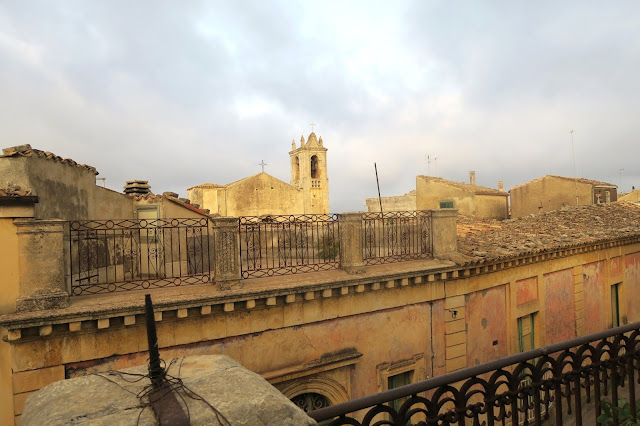As promised, here
is Part II, following from my last post on
Sicily Part 1: Modica and those amazing
scacce ragusane.
So our journey
continued through the south eastern side of Sicily with my husband’s delightful
cousins Anna Maria and Salvatore. We
drove to three
additional cities showcasing their ancient beauty and intact Baroque style to
include Siracusa and the island of Ortigia; my father in laws home town Palazzolo Acreide and ending our visit in Noto.


Siracusa & Ortigia Island
Our base stay
was in Syracusa not far from Ortigia Island. I had heard so much about this
historic centre from my friend Rosa who runs yearly tours to Sicily, and has published her
2019 Culinary Tour of Sicily itinerary on her website so do check it out. This
island also known in dialect as ‘
u
scogghiu’ – the rock, is a treasure.
It is connected to
Syracusa by its bridges and walking
distance to its small but charming market.
This market
echoes the Arab influence with its alleys and aromas of various spices,
colourful fresh and preserved local produce and enlivened by catchy phrases being
shouted in Sicilian dialect. I was thrilled to see many Sicilian delicacies
including
cotognata and
marmellata di fichi d'India. The hunks of tuna
and sword fish were so fresh and spectacular to photograph and the seasonal
fruit and vegetables were too good to pass by and not purchase.
Here we also had
our gluttonous stop at the
Caseificio Borderi famous for its
street food and for its ricotta cooked three times served hot with olive oil
and garlic. Just next door is the amazing deli Fratelli Burgio where my
husband found what he could not source here in Melbourne - a jar of minced
sundried tomatoes, preserved in olive oil called cappuliato. Not as good as my mother in law would make but close
enough to evoke wonderful memories of the dishes she would use this condiment
in.



Additional areas
of interest are t
he impressive Cathedral of Syracusa whose
structure includes Doric columns behind a reconstructed Baroque facade; and the church of
Santa Lucia alla Badia, which houses the painting of
Caravaggio, The Burial of Saint Lucy. W
e
walked along the characteristic Via del Crocefisso, in the Giudecca
district inhabited by the Jews until 1492; and did some subterranean
exploration through the Ipogei di Piazza Duomo, a set of
underground tunnels used during the Second World War as a refuge from bombing.
Overlooking the sea is Fonte Aretusa, a
fountain that originates in a fresh water spring and creates a small
semicircular lake with fish, geese and ducks and where the plants of the only
natural Papyrus (
Papireto) in Europe
grow luxuriantly.
In Syracusa, the
central Archaeological Park Neapolis is a must, comprising the Roman Amphitheatre,
a Greek
Theatre entirely carved into the rock, and the Ear of Dionysius – called
this way for its ear shape and above all for its remarkable acoustic properties amplifying the sounds inside. Across the road from where we were
staying we visited the Santuario della Madonna delle Lacrime built in memory of a
miracle that occurred in 1953, the lacrimation of a plaster effigy of the
Virgin Mary.
Palazzolo Acreide
This town is often overlooked by
tourist circuits, yet Palazzolo Acreide
is well worth a visit. It is a UNESCO World Heritage town that boasts prized
Baroque churches, palazzi and
intricate facades. Less busy than Syracusa
except when they celebrate their Saints. Although we just missed this religious event, on
the 29 June the town
celebrates the colourful Festa di San Paolo and ‘u giru ro pani’ - the tour and blessing of the bread. The statue of the patron saint comes out of
the church in a blaze of fireworks, confetti and streamers, and paraded through
the alleys of the historic centre and referred to as 'a sciuta' - the reveal.
This is my father in laws hometown and
where my husband’s last living aunt still resides. Reunited with zia Carmela was an emotional day
and the privilege to visit her in her home - one of the towns oldest Baroque palazzo’s
was a highlight. Located in via Garibaldi, its facade has different anthropomorphic and fantastic masks representing
figures linked to the magical and mystical world and a labyrinth of rooms, all of which
are slowly being meticulously restored. We were
encouraged to take many photos with plans for the girls to paint and draw some
artworks for the family and for me to document this family treasure.
And of course the food of this town, one must not
miss the obligatory stop at
the Corsino pastry
shop in via
Nazionale, which since 1889 offers the best of Sicilian gastronomy from the
classic arancini to the cannoli, as well as almond sweets. An
unexpected culinary highlight for me however, was had at
Ristorante La Trota a local
salmon and trout farm established in the 1960’s just 7 km out of
Palazzolo Acreide, whose restaurant was built in a natural grotto. Here our
hosts chose a degustation of trout prepared eight different ways to include a
trout ceviche with lemon sorbet.
Our last day before flying out of
Catania was spent in
Noto. I will post about this city and its famous
granita alla mandorla with recipe, at the end of the month as part of my contribution to our
Cucina Conversations quarterly posts.
Stay tuned!




















Comments
Post a Comment